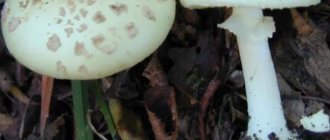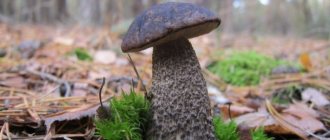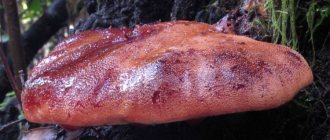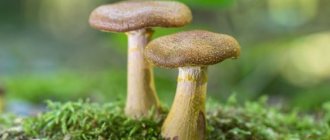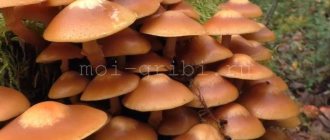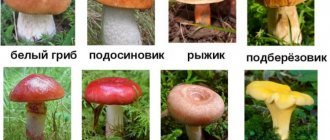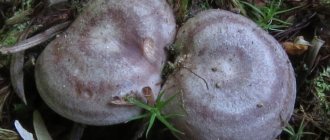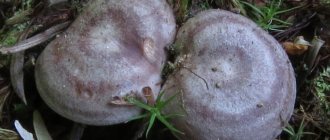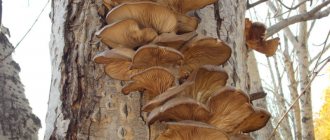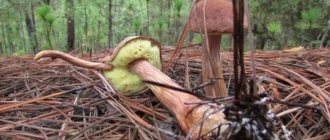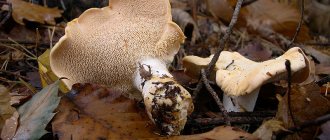More than 600 species of fly agarics are found in nature. Some of them can be eaten and used to prepare medicinal compounds, but most of them are extremely poisonous. The white fly agaric (amanita verna) is a very dangerous mushroom that can easily be confused with edible mushrooms. Such a mistake can cause poisoning and even death.
What does a white fly agaric look like?
Types of these mushrooms, appearance
The fly agaric family includes about 600 varieties of agaric mushrooms - poisonous, hallucinogenic, conditionally edible and even edible, which can be eaten. Representatives of all “fly agaric” varieties are very similar to each other. But each of the species has its own purely characteristic differences and characteristics, and the description of each studied contains their specific characteristics and differences characteristic of various representatives of the family. Spring toadstool, or spring white fly agaric, description and photo of a flora that is deadly to humans.
Representatives of this species of the family are bright white from the cap to the base of the stalk, including the spore plates, which are also white. The diameter of the cap reaches 10 cm, the height of the stem is up to 13 cm. The shape of the cap is round-conical, over time it opens into a round umbrella with a ribbed edge and a soft, silky surface to the touch. At the top of the cap, as a rule, there is a depression, but there are also caps with a tubercle.
The leg has a cylindrical shape. The trunk is thick, hollow, with an ovoid (tuber-like) thickening at the base. The stem ring is wide, the texture of the ring is silky. The pattern of densely spaced plates is frequent. In extremely rare cases, the plates are colored pinkish.
Habitat and distribution
It is assumed that the stinking fly agaric, like all types of fly agarics, is a mycorrhiza. This means that the fungal mycelium forms a symbiotic relationship with the roots of the trees. Often found near oak and pine trees. Sometimes found alongside other hardwoods such as chestnut (Castanea satiba), beech (Fagus sylvatica), birch, pine (Pinus), spruce (Picea abies) and fir (Abies alba).
In European territory, mushrooms usually appear in July, August and September.
The stinking fly agaric was originally a European mushroom and was found throughout Europe and parts of North Africa.
However, this species was introduced to North America and spread to almost its entire territory.
The supply of wood, lumber and live seedlings has led to the spread of this species to other parts of the world, such as Australia and some countries in South America.
Where, when and how does it grow
The spring grebe, starting from mid-spring, is found not only in coniferous forests. Representatives of the family grow in swamps, along river beds, on ravine slopes, as well as in wet floodplain lowlands. The poisonous stink bug grows both singly and forming a mushroom colony. During the rainy summer season it occurs even in August. But, starting in September, representatives of this species of fly agarics simply disappear.
Almost all members of the family grow in small groups. Even amanita muscaria, or the red hallucinogenic fellow of the white fly agaric shown in the photo, is not found often, as a single individual, or in a colony of 3-5 pieces. White fly agaric, dangerous due to its toxicity, grows en masse, in huge groups.
In appearance it is similar to the ovoid white fly agaric, a conditionally edible representative of the family. The ovoid species is collected with caution, since there is a high risk of mistaking a super-poisonous individual for a harmless edible fungus. Even more often, the spring toadstool is confused with its gray-pink edible brother, as well as with the Caesar mushroom - Caesar fly agaric (Caesar mushroom), which you can see in detail in the photo in the gallery.
Habitat
The fruiting period of the white fly agaric begins in June and ends in early November. The mushroom grows most often in mixed and coniferous forests. It grows mainly on calcareous soils, less often on the slopes of ravines, along rivers or swamps. Prefers a humid climate. They are found both in groups and individually. A large number of these mushrooms are concentrated in regions with a temperate warm climate.
Application
Since childhood, many of us, when we mention the fly agaric, have a picture of a bright red thick fly agaric with white dots, driving away flies. But a particularly toxic, smelly mushroom is not suitable for repelling insects - it will poison everything around. The only niche occupied by a particularly dangerous representative of the Amanitaceae family is its use in folk medicine.
For a long time, with the help of mushroom tinctures and decoctions of white fly agaric, human metabolism has been normalized. Recent biochemical studies have shown that the spring toadstool contains a fair amount of the biogenic amine choline, a vitamin-like (vitamin B4) substance with high physiological activity that can influence human metabolism and reduce cholesterol levels. Healers keep the proportions and recipes for making mushroom infusions a big secret.
Symptoms of stinking fly agaric poisoning
Symptoms of poisoning from this mushroom usually do not appear until 5-24 hours after ingestion. Initial symptoms are similar to food poisoning: diarrhea, nausea, vomiting, abdominal pain, etc. Over the next 1-2 days, the patient may experience pain, jaundice, bleeding as the production of clotting factors in the liver stops, kidney failure, then progressive consequences of widespread organ failure with seizures, hepatic coma and death.
In less severe cases, liver damage may be reversed with only mild coagulopathy, but in cases of severe poisoning, complete irreversible liver failure will make death inevitable. The only hope for survival is a complete liver transplant.
How to distinguish edible from inedible
The similarity between representatives of the same species is understandable. However, spring toadstools are easily mistaken for the edible variety. When young, it can easily be confused with small champignons. But the champignon plates have a soft pink or slightly brown tint.
Most often, the spring toadstool is mistaken for a white float - an absolutely harmless, tasty edible mushroom. Unlike its poisonous counterpart, the float has a pronounced mushroom aroma, and there is no ring on the stem. Or for the umbrella mushroom, whose trunk is much denser and more fibrous, as well as for the white russula.
Important! The main difference from edible mushrooms of its poisonous relative is the smell. A cut poisonous specimen does not emit a mushroom aroma. On the contrary, the cut smells intensely of bleach solution spilled on the ground.
About the deadly poisonous mushrooms of our forests
The most dangerous in this regard is the pale grebe (Amanita phalloides, green fly agaric). The greenish caps of the toadstool are often mistaken for russula. But many people simply do not pay attention to other signs of the fungus (volva, ring). People manage to confuse toadstool with champignons.
The small-sized mushroom Galerina fringe is very dangerous. Galerina is very similar to the summer honey fungus, and lovers of this mushroom need to be more careful. The poisons of Galerina are the same as those of the pale grebe.
Several other types of deadly poisonous mushrooms are found in European forests. This is a Patouillard fiber, which has no resemblance to edible mushrooms. These are two or three types of spider webs. It is better to take mushrooms from the genus Cobweb, having a firm belief that this species is edible.
There are also poisonous lepiots. They somewhat resemble edible and even delicious umbrella mushrooms (genus Macrolepiotes), but are very small compared to umbrellas.
The waxy golovushka is also deadly poisonous; the fungus is very small and is not similar to popular mushrooms for collecting. It is also better not to take talkers with whitish colored caps.
What I am saying is that poisonous mushrooms (and above all, deadly poisonous ones) are not so difficult to remember.
And there are two more types of deadly poisonous fly agarics in our forests: the spring fly agaric (Amanita verna) and the stinking fly agaric (white toadstool, Amanita virosa).
This is what a white grebe looks like “in its youth”
However, some mycologists (for example, Mikhail Vishnevsky) consider these fly agarics to be one species. There are simply forms of the fungus that form fruiting bodies at different times - in spring (A. verna) or in late summer - autumn (A. virosa).
Be that as it may, the stinking fly agaric, or white toadstool, is similar in its chemical composition and toxic properties to the pale toadstool.
If the pale grebe can be very numerous in the forests of the middle zone, then in the north it is already less common. For example, I have been unsuccessfully looking for this mushroom in the surrounding forests for several years now.
White toadstool (fly agaric) is a quite common mushroom in the northern and northeastern forests. Apparently, this species replaces the pale grebe in more severe climatic conditions.
Chemical composition
Two groups of particularly toxic substances are contained in mushroom pulp. The first group contains muscarine, serotonin, muscimol, bufotenine, ibotenic acid. These five substances underlie the properties of the red fly agaric, which cause hallucinations when poisoned. The second group is characterized by the content of toxic substances - scopolamine and hyoscyamine, tropane alkaloids, which cause severe intoxication, like henbane. The combination of two severe toxins can be fatal if a person eats more than five poisonous mushrooms.
Deadly white fly agaric, photo and description of symptoms resulting from poisoning with poisonous mushroom food, occurring just an hour after eating it:
- nausea with uncontrollable vomiting;
- persistent diarrhea;
- dryness of all mucous membranes, acquiring a gray tint;
- difficulty breathing and tachycardia;
- rapid increase in body temperature;
- dilated pupils;
- twilight of consciousness;
- excitement alternates with euphoria;
- hallucinations;
- without medical help – death.
Virulence
The toxicity of white fly agaric is due to the presence in its composition of a substance such as muscarine. Literally 6 of these mushrooms will be enough to cause fatal poisoning. Even doctors are powerless in such cases. The gastrointestinal tract and liver are the first to be affected. Symptoms occur 6 to 48 hours after eating white fly agaric. These include: vomiting, constant thirst, acute stomach pain, diarrhea, muscle pain, decreased blood pressure and pulse. Muscarine leads to damage to the nervous system, which can provoke a hallucinogenic effect. When the first symptoms appear, you must immediately call an ambulance. Before doctors arrive, it is recommended to rinse the stomach by drinking a large amount of water and inducing vomiting. Activated carbon and a solution with potassium permanganate will also help alleviate the condition. The salvation of the victim directly depends on the speed of arrival of doctors. Otherwise, the patient must be taken to the hospital independently.
It is noteworthy that even a coating of fungus, which can get on the skin if you touch it, is dangerous. In this case, you must immediately wash your hands with water. If a white fly agaric gets into a basket with other mushrooms, then everything will have to be thrown away, since the poison of the white fly agaric will spread to all the mushrooms and lead to moderate poisoning.
One hundred percent killer
We are talking about the pale grebe. It is more poisonous than the red fly agaric. It is scarier than even the panther fly agaric (Amanita pantherina). At the same time, it can disguise itself as green russula and champignons. It can also be mistaken for white float, which, after bleaching, is stewed and fried.
To be fair, most mushroom pickers can easily distinguish the pale toadstool from other mushrooms due to its unique length of the stem. At the same time, they will never pick russula if there is even a hint of the characteristic “ring” on it, and they will definitely refuse champignon that has light plates visible. In any case, if in doubt, as in the case of a float, it is better to refuse collection altogether.
For those mushroom pickers who take this lightly, old-timers will tell you in detail about the toxic effect of toadstool. It turns out that first the liver and kidneys fail, then the capillaries of the walls of the heart and stomach are destroyed, and finally brain swelling occurs. Doctors are usually powerless. After such a story at a rest stop, many newcomers immediately throw away their harvest. By the way, oncologists have become interested in this mushroom, working to turn some toadstool toxins into a cure for cancer.
White toadstool poisoning
Poisoning with white toadstool, or stinking fly agaric, is characterized by several stages of development. This pathology manifests itself only after a day or two, because by this time the mucous membrane of the intestinal tract is affected, which provokes acute pain, diarrhea and nausea, followed by vomiting. The next stage of poisoning involves an imaginary improvement in the condition, but at this time the disease does not subside. At the final stage, problems with the kidneys and liver are most acute, causing the person to die soon.
If the following symptoms of poisoning occur, be sure to immediately contact a medical facility: vomiting, intestinal colic, abdominal pain, thirst, diarrhea with blood, pallor, convulsions, low body temperature, muscle pain, deterioration of visual activity, weak pulse.
Irina Selyutina (Biologist):
The white toadstool is as deadly a mushroom as the pale toadstool. In addition to amatoxins and phallotoxins, the fruiting bodies of the fly agaric also contain the toxin virosine. 1 kg of fresh fruiting bodies of this mushroom contains 0.25 g of virosine. The most toxic are the volva and the flesh of the cap, but the plates and stem of the fruiting body contain less toxin. As with the pale toadstool, in the case of the stinking fly agaric, it is recommended to touch it in the forest with your hands and not put it in a basket with previously collected edible mushrooms in order to avoid their poisoning.
To save the victim, 4 categories of treatment are used:
- preliminary medical assistance;
- medical support measures;
- special medical procedures;
- liver transplantation.
Unfortunately, very often the only way to save a person’s life is a liver transplant.
To provide first aid to the victim, the stomach is washed with boiled water with salt or potassium permanganate. Also, one should not forget about the effect of activated carbon. The invaluable help of milk thistle has been proven. To make an antidote, pour boiling water over a teaspoon of the herb, steam for half an hour, infuse with further straining and give the patient a third of a glass three times a day.
Fly agaric family
Why did we touch on the topic of the pale toadstool, if our site is about red fly agarics, the answer is simple, the pale grebe and all of the above species of its close relatives are relatives of the red fly agaric, this is for information, so that you know where these mushrooms have a relationship. The red fly agaric belongs to the fly agaric family, genus fly agaric. The pallid grebe also belongs to the fly agaric family, genus fly agaric.
Everything that we have written here is based only on our experience and if someone disagrees with something, please send us your articles, we will be happy to publish them on our website or supplement existing articles, indicating the author of these materials.
Collect the right mushrooms!
For those who like to copy other people's publications, we inform you right away that these texts are classified as objects of copyright, are listed in search engines as primary sources, think before you copy.
False mushrooms and false fear
Beginning mushroom pickers are like inexperienced sappers. They go into the forest with sad and sometimes apocalytic thoughts, “what if I can’t distinguish a real mushroom from a false one.” If in doubt, you can do a small toxicity test.
There is a lot of useful advice in the specialized literature. For example, in an acidic environment, orange talkers (false chanterelles) lose their orange color, turning into whitish lumps. Meanwhile, a real mushroom will never do this.
Actually, false chanterelles are unusually beautiful, however, when they grow. But as soon as they are picked, they immediately lose their photogenic appearance. Perhaps this is why poisoning with them almost never occurs. But real milk mushrooms differ from false ones in that when you press on the cap of the original, drops of milky color do not appear. Meanwhile, this liquid with a slight coconut odor indicates the presence of muscarinic substances. After eating such a false mushroom, a person suffers from vomiting and diarrhea for a long time.
Is dried toadstool dangerous?
In dried form, all these mushrooms - white fly agaric, spring fly agaric, stinking fly agaric, white float, red champignon - are very difficult to distinguish from each other, and if you have never seen them, then most likely you will not identify them yourself.
In dried form, toadstool, white fly agaric, spring fly, and stinking fly also retain their poisons and are very dangerous. Do not buy such mushrooms even from mushroom pickers you know. Well, for example, your father’s friend Uncle Petya, a famous mushroom picker, boasted that he had dried a lot of white floats, and how tasty the soup is when you add them, he invites you to buy some mushrooms from him, because he has a lot of them for the winter. Never agree to buy such mushrooms, otherwise you may pay with your life.
What conclusions can be drawn, despite the fact that these mushrooms, which we have all written about here, are quite rare and even when you meet them they look scary, you need to remember their distinctive features and collect only familiar mushrooms.
It's better not to take risks
Most often, false mushrooms contain monomethylhydrazine, which causes severe forms of poisoning. In reality, the danger depends on the concentration of toxins, and it varies - from fatal to barely noticeable.
Take sulfur-yellow false honey. It belongs to the mildly poisonous mushrooms, and brick-red false foam generally acquires a medicinal effect after boiling. In Japan they even fry it after bleaching it first.
In Karelia there is also a folk recipe for preparing these mushrooms with garlic and onions. However, experts still advise not to take risks. Among these false and conditionally poisonous mushrooms there are real killers, which are almost impossible to guess.
It all depends on what organic substances they feed on. In addition, mushrooms perfectly absorb inorganic substances, such as heavy metals. Meanwhile, two poisons, each of which is a weak toxin, together can cause severe poisoning.
